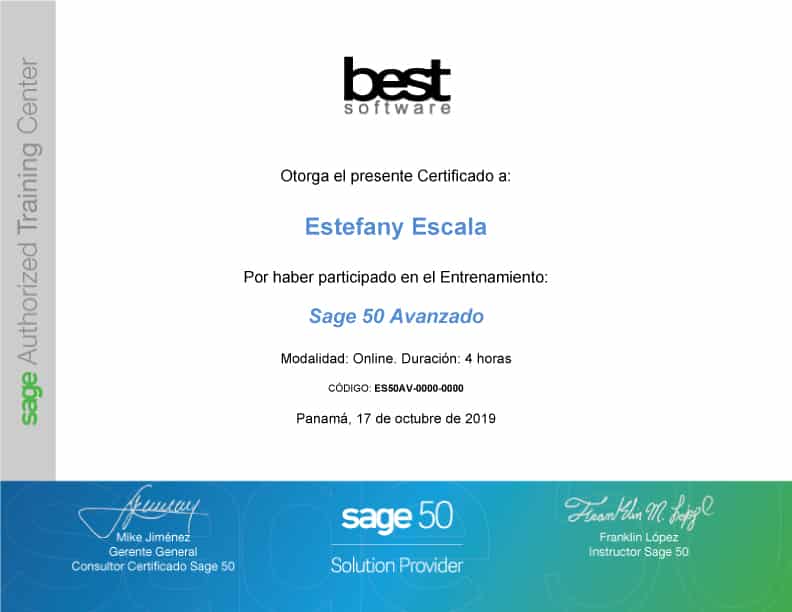Lo que aprenderás
- Lección 1 — Usando Funciones Periódicas del Libro Mayor
- Lección 2 — Funciones Periódicas de Cuentas por Pagar
- Lección 3 — Funciones Periódicas de Inventario
- Lección 4 — Funciones Periódicas de Cuentas por Cobrar
- Lección 5 — Funciones Periódicas de Payroll
- Lección 6 — Configuración y uso de Facturación de Tiempo
- Lección 7 — Configuración y uso de Job Cost
- Lección 8 — Sage 50 Quantum Accounting
- Lección 9 — Personalizando Sage 50
Requerimientos
Haber cursado Sag 50 Básico
Descripción
37 ejercicios prácticos para dominar procedimientos de contabilidad más efectivamente.
Para quién es este curso
Asistentes administrativos, contadores y auxiliares de bufetes.
Los estudiantes también compraron

|
Entrenamiento Sage 50 EsencialBestseller4 horas — Actualización 11/2023 |
4.7 | 236 |
US$ 100 |

|
Entrenamiento Sage 50 BásicoMejor Valorado6 horas — Actualización 11/2023 |
4.5 | 283 |
US$ 300 |
Los estudiantes también compraron

|
Entrenamiento Sage 50 EsencialBestseller |
4.7 | 236 |
US$ 100 |

|
Entrenamiento Sage 50 BásicoMejor Valorado |
4.5 | 283 |
US$ 300 |
Contenido del curso 9 lecciones – 37 ejercicios
Lesson 1 — Using Periodic General Ledger Functions
Entering Account Budgets
Consolidating Sage 50 Accounting Companies
Apply What You Have Learned
- Exercise 1.1 – Entering Budgets
- Exercise 1.2 – Copying and Adjusting Budget Information
Lesson 2 — Using Periodic Accounts Payable Functions
Creating Purchase Orders Automatically
Processing a Prepayment
Paying a Vender Using a Credit Card
Recording a Vendor Refund
Managing 1099 Vendors
Check Your Knowledge
Apply What You Have Learned
- Exercise 2.1 – Creating Purchase Orders Automatically from Sales Transactions
- Exercise 2.2 – Automatically Create Purchase Orders for Items
Lesson 3 — Using Periodic Inventory Functions
Creating Master Stock Items
Utilizing Serialized Inventory Items
Changing Item Prices
Tracking Assembly Builds With Work Tickets
Revising the Bill of Materials
Using Multi-Pack / Units of Measure
Valuting Inventory
Check Your Knowledge
Apply What You Have Learned
- Exercise 3.1 ndash; Creating Master and Substock Items
- Exercise 3.2 – Creating Serialized Inventory Items
- Exercise 3.3 – Receiving Serialized Inventory/li>
- Exercise 3.4 – Selling a Serialized Inventory Item
- Exercise 3.5 – Changing Item Prices
Lesson 4 — Using Periodic Accounts Receivable Functions
Processing a Prepayment
Recording a Customer Refund
Managing Customers eho are also Vendors
Applying Finance Charges
Writing Off Bad Debts
Reconciling Aged Receivables with the General Ledger
Check Your Knowledge
Apply What You Hace Learned
- Exercise 4.1 – Entering a Customer Refund
- Exercise 4.2 – Writing off Bad Debt
Lesson 5 — Using Periodic Payroll Functions
Entering Flat-Rate Payroll Fields
Entering Calculated Payroll Fields
Understanding Adjusted Gross
Check Your Knowledge
Apply What You Have Learned
- Exercise 5.1 – Setting up a Flat-Rate Deduction
Lesson 6 — Setting Up and Using Time and Billing
Introduction
Adding Time Ticket Employees
Entering Time Tickets
Using Time Tickets to Pay Employees
Entering Expense Tickets
Applying Tickets to Sales Invoices
Time and Expense Reports
Check Your Knowledge
Apply What You Have Learned
- Exercise 6.1 – Adding Time Ticket Employees
- Exercise 6.2 – Adding Activity Items
- Exercise 6.3 – Adding Charge Items
- Exercise 6.4 – Entering Time Tickets Using the Daily Tab
- Exercise 6.5 – Entering Time Tickets Using the Weekly Timesheet
- Exercise 6.6 – Using Time Ticet Hours in Payroll
- Exercise 6.7 – Entering Expense Tickets
- Exercise 6.8 – Applying Time and Expense Tickets to Customer Invoices
Lesson 7 — Setting Up and Using Job Cost
Introduction
Entering Job Defaults
Adding Jobs
Adding Phases
Adding Cost Codes
Entering Job Beginning Balances
Entering Job Estimates
Selecting a Job
Using Jobs with Accounts Payable
Using Jobs with Time Tickets
Using Jobs with Payroll
Using Jobs with Inventory Items
Using Jobs with General Journal Entries
Using Jobs with Accounts Receivable
Job Cost Reports
Advanced Job Features
Check Your Knowledge
Apply What You Have Learned
- Exercise 7.1 – Setting up a Job
- Exercise 7.2 – Setting up Phases
- Exercise 7.3 – Setting up Cost Codes
- Exercise 7.4 – Creating a Job Estimate
- Exercise 7.5 – Copying From an Existing Job
- Exersice 7.6 – Applying Purchases to a Job
- Exercise 7.7 – Applying Time Tickets to a Job
- Exercise 7.8 – Applying Payroll Hours to a Job
- Exercise 7.9 – Applying Inventory Cost to a Job
- Exercise 7.10 – Posting Overhead to a Job
- Exercise 7.11 – Entering a Contract Bill as a Sales Order
- Exercise 7.12 – Billing a Contracted Job
- Exercise 7.13 – Billing a Cost Plus Job
- Exercise 7.14 – Applying Sales to a Job
Lesson 8 — Using Sage 50 Quantum Accounting
Establishing Security Roles
Utilizing SmartPosting
Utilizing Order Process Workflow
Configuring My Dashboard
Lesson 9 — Customizing Sage 50 Accounting
Modifying Task Window Layouts
Utilizing Memorized Transactions
Copying Transactions
Customizing the Sage 50 Accounting Desktop
Apply What You Have Learned
- Exercise 9.1 – Setting up a Sales Invoice Layout
- Exercise 9.2 – Entering a Memorized Transaction
- Exercise 9.3 – Using a Memorized Transaction
Instructor
Franklin López C.P.A.

|
Calificación del instructor: 4,6 81 reseñas 540 estudiantes 9 cursos |
Tanto en Best Software como particularmente, ha impartido cursos de Peachtree y ahora de Sage 50 capacitando a más de 500 estudiantes. Franklin ofrece una buena mezcla de pasión por la práctica de su profesión como C.P.A., como técnico en computadoras y como fanático de Peachtree.
Su objetivo es capacitar a los que quieren aprender, que apenas comienzan y quieren conseguir trabajo, así como los experimentados que necesitan mejorar sus habilidades como usuarios avanzados para conseguir el máximo provecho de su software de contabilidad, Sage 50.



